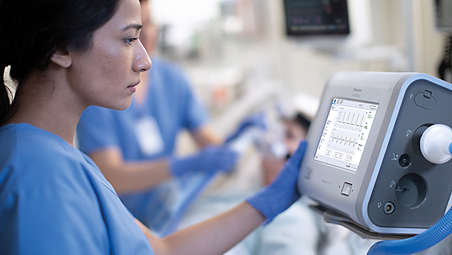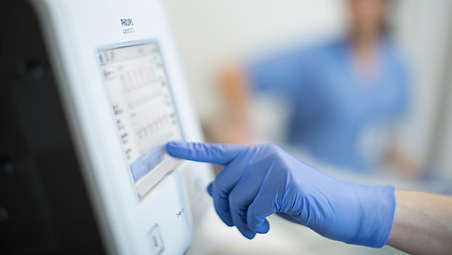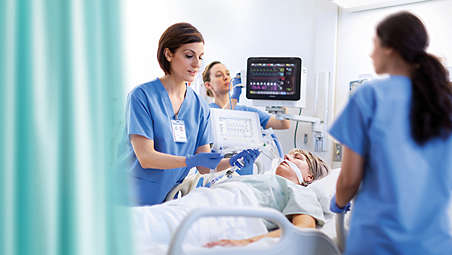Especificaciones
- Modos de respiración
-
Modos de respiración A/C-PC - Control asistido (regulador de presión)
A/C-VC - Control asistido (control de volumen)
CPAP - Presión positiva continua en las vías respiratorias
PSV - Ventilación con presión de soporte
S/T - Ventilación temporizada/espontánea
SIMV-PC - Ventilación obligatoria intermitente sincronizada (regulador de presión)
SIMV-VC - Ventilación obligatoria intermitente sincronizada (control de volumen)
-
- Sistema físico
-
Sistema físico Weight - 6,3 Kg (13,8 lb) con batería intercambiable sin desconexión
Size - 19,3cm de profundidad x 28,6cm de ancho x 24,5cm(7,6 pulg profundidadx11,25 pulg de anchox9,65 pulg)
Screen dimensions - 20,32 cm (8 pulg.)
Ingress protection - IP22: protección contra objetos del tamaño de dedo y a prueba de goteo cuando un máximo de 15 grados
-
- Oxígeno
-
Oxígeno Low flow - 0 a 30 l/min; 10 psi como máximo
High pressure - 280 a 600 kPa (de 41 a 87 psi)
-
- Parámetros del paciente medidos y visualizados
-
Parámetros del paciente medidos y visualizados Tidal volume (Vti or Vte) - 0 a 2000 ml
Minute ventilation (MinVent) - 0 a 30 l/min
Leak - 0 a 200 l/min
Respiratory rate (RR) - 0 a 90 BPM
Peak inspiratory flow PIF - 0 a 200 l/min
Peak inspiratory pressure PIP - 0 a 90 cmH₂O
Mean airway pressure - 0 a 90 cmH₂O
Spontaneous triggered breaths - 0 a 100 %
I:E ratio - 9,9:1 a 1:9,9
Dynamic compliance (Dyn C) - 1 a 100 ml/cmH₂O
Dynamic resistance (Dyn R) - 5 a 200 cmH₂O/l/seg
Dynamic plateau pressure - 0 a 90 cmH₂O
Auto-PEEP - 0 a 20 cmH₂O
FiO₂ with FiO₂ sensor - 21 a 100 %
SpO₂ with pulse oximeter - 0 a 100 %
Pulse rate with pulse oximeter - 18 a 321 PPM
EtCO₂ with CO₂ accessory - 0 a 150 mmHg
-
- Sistema eléctrico
-
Sistema eléctrico AC input voltage - 100 V a 240 V; 50/60 Hz; 1,7 a 0,6 A
DC input voltage - 12/24 V; 6,5 A
Li-ion batteries - Baterías de iones de litio sin desconexión:7,5 horas cada período nominal total(según IEC80601-2-72)
Charge time for battery - Tiempo de carga para la batería desmontable e interna:de 0% al 80%: 2,5 horas; de0% al 100%:3,5horas
-
- Alarmas
-
Alarmas Inspiratory Pressure - 1 - 90 cmH₂O
Tidal Volume - Desactivado, 10 a 2000 ml
Minute Ventilation - Desactivado, 0,2 a 30 l/min
Respiratory Rate - Desactivado, 1 a 90 BPM
Circuit Disconnection - Desactivada, 5 a 60 s
Apnea Interval - 5 a 60 s.
-
- Medioambiente
-
Medioambiente Operating Conditions - 0 °C a 40°C, 5%-90%HR (sin condensación);presión atmosférica:62 a 106kPa;altitud:-1261 a 12,971 pies
Transient operating temp - +20 °C a +50 °C
Storage temperature - Temperatura: -25 °C a 70 °C; humedad relativa: 5 % a 93 %; RH: sin condensación
-
- Controles
-
Controles AVAPS with passive circuit - Solo para los modos PSV, S/T y A/C-PC
Tidal volume - 35 a 2000ml en circuitos dedoble rama y de flujo activo,50 a 2000ml en circuitos PAP activosypasivos
Breath rate - 0 a 80 BPM
PEEP - 0 a 35 cmH₂0 para circuitos activos; 3 a 25 cmH₂0 para circuitos pasivos
EPAP/CPAP - 3 - 25 cmH₂0
IPAP - 3 - 60 cmH₂0
Pressure support/control - 0 - 60 cmH₂0
Inspiratory time - 0,3 a 5 seg
Rise time - 0-6 seg
Triggering and cycling - Apagado, Auto-Trak, sensible, Auto-Trak y activación por flujo
Flow trigger sensitivity - 0,5 a 9 l/min
Flow cycle sensitivity - 10 % al 90 % del flujo máximo
Flow pattern - Cuadrado, rampa
FiO₂ - 21 % al 100 %
Inspiratory time min/max - 0,3 a 3 seg
Backup ventilation - ENCENDIDO, APAGADO
-
- Estándares
-
Estándares General - IEC 60601-1-1 Equipo médico eléctrico. Parte 1-1: Requisitos generales de seguridad
Collateral - IEC 60601-1-11 Entorno de atención médica en el hogar según el uso válido para el transporte
Particular - ISO 80601-2-72 Parte2-72 ISO 80601-2-12 Parte2-12 ISO 80601-2-61 Parte2-61 ISO 80601-2-55 Parte 2-55
Wireless communication - Bluetooth v4.1, ISO/IEC 18092:2013, 21481 ed 2.0, 14443 ed 2.0, WLAN Std: IEEE 802.11 (2012) b/g/n
-
- Modos de respiración
-
Modos de respiración A/C-PC - Control asistido (regulador de presión)
A/C-VC - Control asistido (control de volumen)
-
- Sistema físico
-
Sistema físico Weight - 6,3 Kg (13,8 lb) con batería intercambiable sin desconexión
Size - 19,3cm de profundidad x 28,6cm de ancho x 24,5cm(7,6 pulg profundidadx11,25 pulg de anchox9,65 pulg)
-
- Modos de respiración
-
Modos de respiración A/C-PC - Control asistido (regulador de presión)
A/C-VC - Control asistido (control de volumen)
CPAP - Presión positiva continua en las vías respiratorias
PSV - Ventilación con presión de soporte
S/T - Ventilación temporizada/espontánea
SIMV-PC - Ventilación obligatoria intermitente sincronizada (regulador de presión)
SIMV-VC - Ventilación obligatoria intermitente sincronizada (control de volumen)
-
- Sistema físico
-
Sistema físico Weight - 6,3 Kg (13,8 lb) con batería intercambiable sin desconexión
Size - 19,3cm de profundidad x 28,6cm de ancho x 24,5cm(7,6 pulg profundidadx11,25 pulg de anchox9,65 pulg)
Screen dimensions - 20,32 cm (8 pulg.)
Ingress protection - IP22: protección contra objetos del tamaño de dedo y a prueba de goteo cuando un máximo de 15 grados
-
- Oxígeno
-
Oxígeno Low flow - 0 a 30 l/min; 10 psi como máximo
High pressure - 280 a 600 kPa (de 41 a 87 psi)
-
- Parámetros del paciente medidos y visualizados
-
Parámetros del paciente medidos y visualizados Tidal volume (Vti or Vte) - 0 a 2000 ml
Minute ventilation (MinVent) - 0 a 30 l/min
Leak - 0 a 200 l/min
Respiratory rate (RR) - 0 a 90 BPM
Peak inspiratory flow PIF - 0 a 200 l/min
Peak inspiratory pressure PIP - 0 a 90 cmH₂O
Mean airway pressure - 0 a 90 cmH₂O
Spontaneous triggered breaths - 0 a 100 %
I:E ratio - 9,9:1 a 1:9,9
Dynamic compliance (Dyn C) - 1 a 100 ml/cmH₂O
Dynamic resistance (Dyn R) - 5 a 200 cmH₂O/l/seg
Dynamic plateau pressure - 0 a 90 cmH₂O
Auto-PEEP - 0 a 20 cmH₂O
FiO₂ with FiO₂ sensor - 21 a 100 %
SpO₂ with pulse oximeter - 0 a 100 %
Pulse rate with pulse oximeter - 18 a 321 PPM
EtCO₂ with CO₂ accessory - 0 a 150 mmHg
-
- Sistema eléctrico
-
Sistema eléctrico AC input voltage - 100 V a 240 V; 50/60 Hz; 1,7 a 0,6 A
DC input voltage - 12/24 V; 6,5 A
Li-ion batteries - Baterías de iones de litio sin desconexión:7,5 horas cada período nominal total(según IEC80601-2-72)
Charge time for battery - Tiempo de carga para la batería desmontable e interna:de 0% al 80%: 2,5 horas; de0% al 100%:3,5horas
-
- Alarmas
-
Alarmas Inspiratory Pressure - 1 - 90 cmH₂O
Tidal Volume - Desactivado, 10 a 2000 ml
Minute Ventilation - Desactivado, 0,2 a 30 l/min
Respiratory Rate - Desactivado, 1 a 90 BPM
Circuit Disconnection - Desactivada, 5 a 60 s
Apnea Interval - 5 a 60 s.
-
- Medioambiente
-
Medioambiente Operating Conditions - 0 °C a 40°C, 5%-90%HR (sin condensación);presión atmosférica:62 a 106kPa;altitud:-1261 a 12,971 pies
Transient operating temp - +20 °C a +50 °C
Storage temperature - Temperatura: -25 °C a 70 °C; humedad relativa: 5 % a 93 %; RH: sin condensación
-
- Controles
-
Controles AVAPS with passive circuit - Solo para los modos PSV, S/T y A/C-PC
Tidal volume - 35 a 2000ml en circuitos dedoble rama y de flujo activo,50 a 2000ml en circuitos PAP activosypasivos
Breath rate - 0 a 80 BPM
PEEP - 0 a 35 cmH₂0 para circuitos activos; 3 a 25 cmH₂0 para circuitos pasivos
EPAP/CPAP - 3 - 25 cmH₂0
IPAP - 3 - 60 cmH₂0
Pressure support/control - 0 - 60 cmH₂0
Inspiratory time - 0,3 a 5 seg
Rise time - 0-6 seg
Triggering and cycling - Apagado, Auto-Trak, sensible, Auto-Trak y activación por flujo
Flow trigger sensitivity - 0,5 a 9 l/min
Flow cycle sensitivity - 10 % al 90 % del flujo máximo
Flow pattern - Cuadrado, rampa
FiO₂ - 21 % al 100 %
Inspiratory time min/max - 0,3 a 3 seg
Backup ventilation - ENCENDIDO, APAGADO
-
- Estándares
-
Estándares General - IEC 60601-1-1 Equipo médico eléctrico. Parte 1-1: Requisitos generales de seguridad
Collateral - IEC 60601-1-11 Entorno de atención médica en el hogar según el uso válido para el transporte
Particular - ISO 80601-2-72 Parte2-72 ISO 80601-2-12 Parte2-12 ISO 80601-2-61 Parte2-61 ISO 80601-2-55 Parte 2-55
Wireless communication - Bluetooth v4.1, ISO/IEC 18092:2013, 21481 ed 2.0, 14443 ed 2.0, WLAN Std: IEEE 802.11 (2012) b/g/n
-
- **Tiempo nominal de ejecución por método en la Comisión Electrotécnica Internacional (7,5 horas/batería). El tiempo de carga de la batería desmontable, de 0 % a 80 %, es de 2,5 horas, mientras que el de la batería interna, de 0 % a 100 %, es de 3,5 horas.




